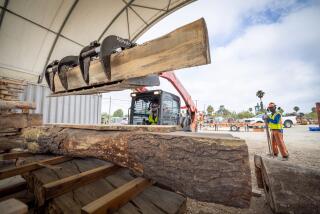Southern Wood Firms Aren’t Just Pining for Bigger Sales : Timber: The lumber suppliers see an opportunity in the Northwest’s misfortunes, and they are promoting their product for a greater number of uses.
ATLANTA — As the fight for the northern spotted owl cuts into Northwest timber production, Southern lumber suppliers are hoping to carve a niche for themselves.
The Southerners are stepping up efforts to promote Southern pine, hoping that customers, faced with rising prices and short supplies, will look to Dixie for wood.
The region’s producers have been looking for more diversified markets since the early 1980s, moving from an almost total reliance on the home construction industry to going after do-it-yourself remodelers, fence and deck builders and the industrial market.
After investing an average of $3 million a year on advertising and seminars with architects and engineers, the industry enjoyed a slow but steady growth through the end of the decade.
The spotted-owl battle in the Pacific Northwest, however, may have cleared the path for greater advances, said Karl Lindberg, president of the Southern Forest Products Assn., based in New Orleans.
“With the environmental challenges in the Northwest,” Lindberg said, timber buyers are “looking for alternative sources. They’re faced with a situation where the amount that’s available may be limited.”
The Northwestern timber industry, which relies largely on forests on publicly owned land, is fighting with environmentalists who believe logging threatens the northern spotted owl, an endangered species. The U.S. Forest Service, which maintains the land, has been blocked from selling timber on more than 66,000 acres in three states. The controversy has been blamed for a steep rise in lumber prices this year. In May, the price for 1,000 board-feet of lumber rose to $311 from $238. The price has fallen slightly since then, however.
The Southern Forest Products effort includes promoting Southern lumber for a variety of uses other than basic home construction.
“Southern pine is a very strong species,” Lindberg said.
So far, those efforts have paid off. While Western lumber production declined 9% last year to 21.1 billion board-feet from 23.2 billion the previous year, overall Southern production increased 3% to 12.9 billion board-feet from 12.5 billion, according to the National Forest Products Assn., a trade group based in Washington, D.C.
Georgia is the South’s lumber production leader, with 2.7 billion board feet a year. Second and third are Mississippi, with 2.2 billion, and Alabama, with 1.9 billion.
Market share for the South also has risen, to 27.3% in 1990 from 25.3% the previous year. The West’s market share fell during that period, to 45.8% from 46.2%, according to the Southern Forest Products Assn.
The market share for Canada, another big producer, fell to 26.7% from 28.2%.
Lindberg said diversified marketing is the main reason for the South’s recent increases. But, he added, “there has been a lot of hysteria in the Pacific Northwest.”
He said the recent price increases were fueled in part by fear that the Northwestern situation would lead to a serious shortage of lumber.
Some industry experts dispute whether there is any shortage in supplies.
“We do get a lot of calls about price increases, but I’ve received none on shortage,” said Gopal Ahluwalia, director of research for the National Assn. of Home Builders.
“I don’t think there’s any shortage,” he said. The problem “is the price increases. And the price increases are all over, even though the problem started in the Northwest.”
Even so, the Northwest’s problems could benefit the South, said Donald Ratajczak, an economist at Georgia State University. He warned, though, that any windfall is likely to be limited and short-lived.
Southern lumber mills are already operating near capacity, so there is limited room for growth, Ratajczak said. And the slowdown in the Northwest is a flimsy premise for starting new mill construction, he said.
“You’re not going to build new mills because of what may be a temporary situation in the Northwest,” he said.
Should the standoff over the spotted owl continue, the situation could lead to massive layoffs in the Northwest, possibly creating a political situation in which the logging restrictions would be lifted, Ratajczak said.
“When that happens, they may look at the owl in a different light,” he said.
The government in August scaled back by about one-fourth the amount of Northwestern forest land it believes warrants special protection to help the northern spotted owl survive. But industry groups, which earlier had projected job losses at 100,000, said the revised proposal will do little to soften the economic blow to that region.
A random telephone survey in July by the Washington, D.C., trade group, the Timber Industry Labor Management Committee, expressed such concern.
In the poll, conducted in Washington and Oregon, 54% of the respondents said the potential for job loss is too great a price to pay for protecting the owl. Most timber forests in the South are privately owned, which would put that industry in a stronger position to fight a similar environmental challenge.
But there could be such a battle there over the fate of the red cockaded woodpecker, an endangered species that lives in Southern forests. A coalition of timber industry groups has filed suit against the government to block a plan to apply the Endangered Species Act to stop logging in forests the bird inhabits.
“We are very concerned about the Northwest, and this is not how we want to expand our market,” Lindberg said. “We could face the same thing with the red cockaded woodpecker.”
The South has also become a more aggressive exporter. About 375 million board-feet of Southern pine--about 4% of the total production--was shipped out of the country last year, he said.
The home-building slump, however, continues to be a dominant factor in the fortunes of the nation’s lumber industry. The slump was the reason given earlier in August when the owners of a Gainesville, Ga., lumberyard decided to shut down after 79 years in business.
“This is a business decision brought on by the effects of the serious slowdown in commercial and residential construction in Gainesville and northeast Georgia over the past two years,” said Ed Chambers Jr., president of the Chambers Lumber Co.
“Although we have seen some brief flurries of building activity since the war ended . . . we do not anticipate a recovery strong enough to keep us in the market,” he said.
More to Read
Inside the business of entertainment
The Wide Shot brings you news, analysis and insights on everything from streaming wars to production — and what it all means for the future.
You may occasionally receive promotional content from the Los Angeles Times.










